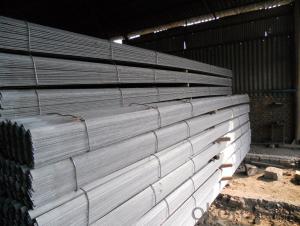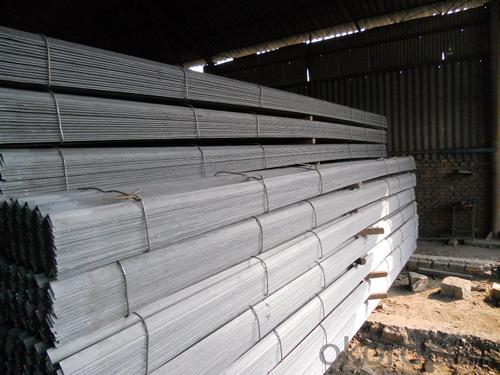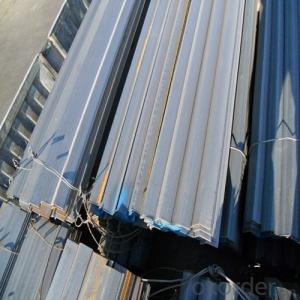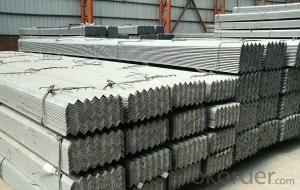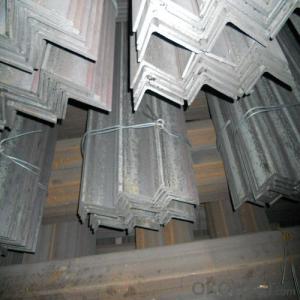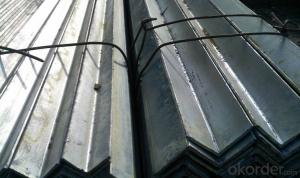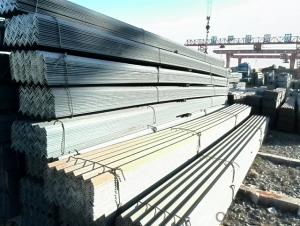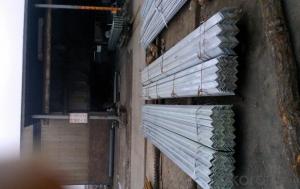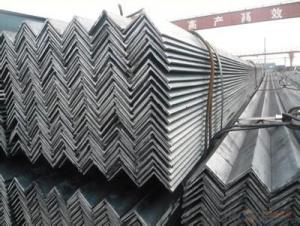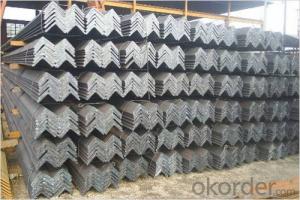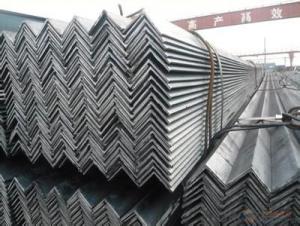Hot Rolled Steel Angle Q235, A36,SS400 for Strcuture
- Loading Port:
- Tianjin
- Payment Terms:
- TT or LC
- Min Order Qty:
- 25 m.t.
- Supply Capability:
- 200000 m.t./month
OKorder Service Pledge
OKorder Financial Service
You Might Also Like
Product Description:
Specifications of Hot Rolled Steel Angle Q235, A36,SS400 for Strcuture
1. Invoicing on theoretical weight or actual weight as customer request
2. Length: 6m, 9m, 12m as following table
3. Sizes
Sizes: 25mm-250mm | ||
a*t | ||
25*2.5-4.0 | 70*6.0-9.0 | 130*9.0-15 |
30*2.5-6.6 | 75*6.0-9.0 | 140*10-14 |
36*3.0-5.0 | 80*5.0-10 | 150*10-20 |
38*2.3-6.0 | 90*7.0-10 | 160*10-16 |
40*3.0-5.0 | 100*6.0-12 | 175*12-15 |
45*4.0-6.0 | 110*8.0-10 | 180*12-18 |
50*4.0-6.0 | 120*6.0-15 | 200*14-25 |
60*4.0-8.0 | 125*8.0-14 | 250*25 |
5. Payment terms:
1).100% irrevocable L/C at sight.
2).30% T/T prepaid and the balance against the copy of B/L.
3).30% T/T prepaid and the balance against L/C
6.Material details:
Alloy No | Grade | Element (%) | |||||
C | Mn | S | P | Si | |||
Q235 | B | 0.12—0.20 | 0.3—0.7 | ≤0.045 | ≤0.045 | ≤0.3 | |
Alloy No | Grade | Yielding strength point( Mpa) | |||||
Thickness (mm) | |||||||
≤16 | >16--40 | >40--60 | >60--100 | ||||
≥ | |||||||
Q235 | B | 235 | 225 | 215 | 205 | ||
Alloy No | Grade | Tensile strength (Mpa) | Elongation after fracture (%) | ||||
Thickness (mm) | |||||||
≤16 | >16--40 | >40--60 | >60--100 | ||||
≥ | |||||||
Q235 | B | 375--500 | 26 | 25 | 24 | 23 | |
Usage & Applications of Hot Rolled Steel Angle Q235, A36,SS400 for Strcuture
According to the needs of different structures, Angle can compose to different force support component, and also can be the connections between components. It is widely used in various building structures and engineering structures such as roof beams, bridges, transmission towers, hoisting machinery and transport machinery, ships, industrial furnaces, reaction tower, container frame and warehouse etc.
Packaging & Delivery of Hot Rolled Steel Angle Q235, A36,SS400 for Strcuture
1. Packing: it is nude packed in bundles by steel wire rod
2. Bundle weight: not more than 3.5MT for bulk vessel; less than 3 MT for container load
3. Marks:
Color marking: There will be color marking on both end of the bundle for the cargo delivered by bulk vessel. That makes it easily to distinguish at the destination port.
Tag mark: there will be tag mark tied up on the bundles. The information usually including supplier logo and name, product name, made in China, shipping marks and other information request by the customer.
If loading by container the marking is not needed, but we will prepare it as customer request.
Production flow of Hot Rolled Steel Angle Q235, A36,SS400 for Strcuture
Material prepare (billet) —heat up—rough rolling—precision rolling—cooling—packing—storage and transportation
Images of Hot Rolled Steel Angle Q235, A36,SS400 for Strcuture
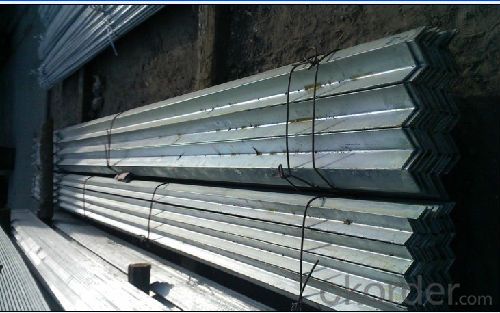
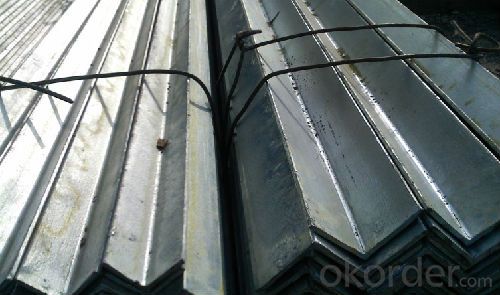
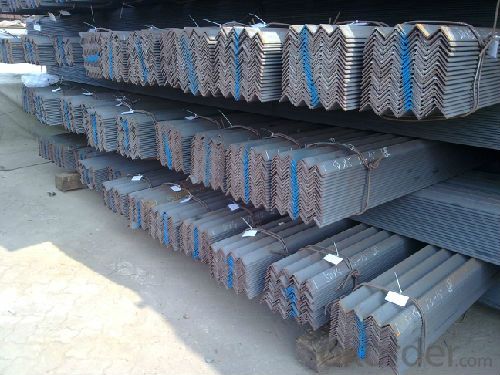
- Q: How are steel angles priced?
- Several factors typically influence the pricing of steel angles. One of these factors is the current market price of steel, which is influenced by elements such as supply and demand, global economic conditions, and fluctuations in the costs of raw materials. The price of steel angles can also be affected by their size and dimensions, with larger and thicker angles generally costing more. The grade and quality of the steel used in the angle also play a role in determining its price. Steel angles made from higher-grade materials, such as stainless steel or alloy steel, tend to be more expensive due to their superior strength and resistance to corrosion. Furthermore, the quantity of steel angles being purchased can impact the price. Bulk orders or larger quantities often qualify for volume discounts, which can reduce the overall cost per unit. Lastly, the pricing of steel angles may also take into account transportation and logistics costs. Factors such as shipping distances, handling fees, and any additional services required for delivery can all contribute to the final price. In conclusion, the pricing of steel angles is determined by a combination of market conditions, size and dimensions, grade and quality, quantity ordered, and transportation costs. It is important to consider these factors when evaluating and comparing prices from different suppliers.
- Q: Can steel angles be used as reinforcements in concrete structures?
- Certainly! Reinforcements in concrete structures can include steel angles. Due to their exceptional strength and durability, steel angles are commonly utilized in concrete structures. These angles are placed within the concrete to provide additional support, preventing cracking or failure when subjected to heavy loads or stress. Steel angles offer versatility and are easily incorporated into the designs of various concrete structures, such as beams, columns, walls, and slabs. They are often combined with other reinforcement materials, like steel bars or mesh, to enhance the overall strength and stability of the concrete structure. The preference for steel angles arises from their ease of installation, cost-effectiveness, and ability to withstand the harsh environmental conditions typically encountered in construction projects.
- Q: Can steel angles be used as structural members?
- Yes, steel angles can be used as structural members. Steel angles are commonly used in construction and engineering projects to provide structural support and stability. They are often used to reinforce and strengthen various structures, such as buildings, bridges, and frameworks. Steel angles are known for their high strength and durability, making them an ideal choice for structural applications. They can be used in combination with other steel components or on their own to bear or distribute loads, support beams, and provide stability to the overall structure. Additionally, steel angles can be easily fabricated and installed, making them a versatile and cost-effective option for structural members in various construction projects.
- Q: How do you determine the required length of a steel angle for a specific application?
- To determine the required length of a steel angle for a specific application, you typically need to consider the dimensions and requirements of the project. This involves taking measurements, understanding the load or weight it will bear, and considering any necessary safety factors. Consulting structural engineering codes or guidelines can also provide valuable information to ensure the angle is appropriately sized for the intended use.
- Q: What is the minimum radius for a curved steel angle beam?
- The minimum radius for a curved steel angle beam depends on various factors such as the size and thickness of the angle beam, the type of steel used, and the specific application requirements. It is recommended to consult structural engineers or refer to relevant design codes and standards for the specific project to determine the appropriate minimum radius for a curved steel angle beam.
- Q: How do you calculate the bending capacity of a steel angle?
- To calculate the bending capacity of a steel angle, you need to determine the moment of inertia of the angle section and the maximum allowable stress. The moment of inertia is calculated using the dimensions of the angle section, and the maximum allowable stress is typically provided by the steel manufacturer. By applying these values to the appropriate bending equation, you can calculate the bending capacity of the steel angle.
- Q: Can steel angles be used for support structures in sports facilities?
- Yes, steel angles can be used for support structures in sports facilities. Steel angles provide excellent strength and stability, making them suitable for supporting various components such as beams, trusses, and frames in sports facilities. They can effectively withstand heavy loads, ensuring the safety and durability of the structure. Additionally, steel angles are versatile and can be easily customized to meet specific design requirements, making them a reliable choice for support structures in sports facilities.
- Q: What is the maximum bending moment for a steel angle?
- The maximum bending moment for a steel angle depends on various factors such as the dimensions, material properties, and loading conditions. It cannot be determined without specific information about the angle and the forces acting on it.
- Q: What is the carbon content of steel angles?
- The carbon content of steel angles may differ based on the particular grade and type of steel employed. Typically, carbon steel angles possess a carbon content that spans from 0.05% to 0.25%. Nevertheless, certain high carbon steel angles can exhibit a carbon content reaching up to 2.1%. The carbon content of steel angles holds significant importance, as it impacts the strength, hardness, and overall characteristics of the steel.
- Q: How are steel angles welded or joined together?
- Different welding techniques are commonly employed to weld or join steel angles. The prevalent method involves the use of arc welding, which encompasses shielded metal arc welding (SMAW), gas metal arc welding (GMAW), and flux-cored arc welding (FCAW). In shielded metal arc welding, an electric arc is established between a coated electrode and the steel angle. This causes the metals to melt and creates a weld joint. Gas metal arc welding, on the other hand, utilizes a continuous wire electrode and a shielding gas like argon or a combination of argon and carbon dioxide. This shielding gas safeguards the weld from atmospheric impurities. Flux-cored arc welding employs a hollow wire electrode containing flux. This generates a shielding gas and slag that protect the weld. Resistance welding is another technique used for joining steel angles. It involves the application of pressure and the passage of an electric current through the joint area. This generates heat, resulting in a weld. Spot welding and seam welding are commonly employed resistance welding methods for steel angles. Furthermore, steel angles can be joined using stud welding. This process entails placing a threaded or unthreaded stud against the steel angle and utilizing an arc welding process to fuse the stud to the angle. It should be noted that the choice of welding or joining method for steel angles depends on factors such as the thickness and type of steel, the desired joint strength, and the specific requirements of the application.
Send your message to us
Hot Rolled Steel Angle Q235, A36,SS400 for Strcuture
- Loading Port:
- Tianjin
- Payment Terms:
- TT or LC
- Min Order Qty:
- 25 m.t.
- Supply Capability:
- 200000 m.t./month
OKorder Service Pledge
OKorder Financial Service
Similar products
Hot products
Hot Searches
Related keywords
